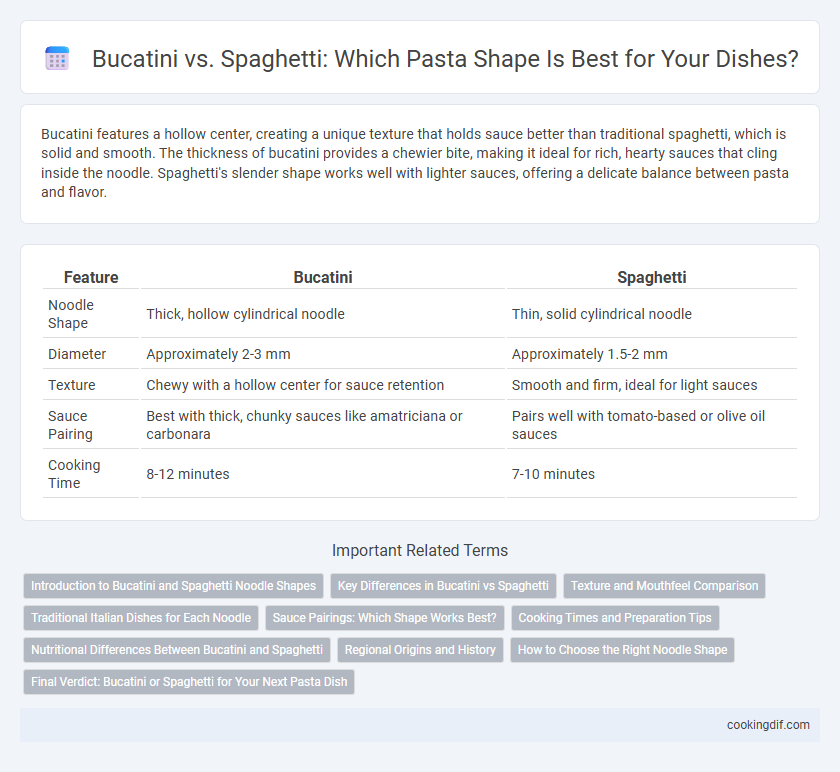Bucatini features a hollow center, creating a unique texture that holds sauce better than traditional spaghetti, which is solid and smooth. The thickness of bucatini provides a chewier bite, making it ideal for rich, hearty sauces that cling inside the noodle. Spaghetti's slender shape works well with lighter sauces, offering a delicate balance between pasta and flavor.
Table of Comparison
| Feature | Bucatini | Spaghetti |
|---|---|---|
| Noodle Shape | Thick, hollow cylindrical noodle | Thin, solid cylindrical noodle |
| Diameter | Approximately 2-3 mm | Approximately 1.5-2 mm |
| Texture | Chewy with a hollow center for sauce retention | Smooth and firm, ideal for light sauces |
| Sauce Pairing | Best with thick, chunky sauces like amatriciana or carbonara | Pairs well with tomato-based or olive oil sauces |
| Cooking Time | 8-12 minutes | 7-10 minutes |
Introduction to Bucatini and Spaghetti Noodle Shapes
Bucatini and spaghetti are both long, cylindrical pasta shapes, but Bucatini features a hollow center that allows sauces to fill the noodle, enhancing flavor absorption and texture contrast. Spaghetti has a solid, thin, and round profile, ideal for clinging to lighter sauces like marinara or olive oil-based dressings. The hollow structure of Bucatini makes it particularly suited for rich, thick sauces, while spaghetti's smooth surface pairs well with delicate recipes.
Key Differences in Bucatini vs Spaghetti
Bucatini features a hollow center, providing a unique texture and allowing sauces to cling both inside and outside the noodle, unlike spaghetti, which is solid and round. Spaghetti's thin, cylindrical shape offers a smooth surface that pairs well with lighter sauces, while bucatini's thickness and tubular form better complement heavier, chunky sauces. The distinctive hollow structure of bucatini enhances the eating experience by delivering bursts of sauce with each bite, setting it apart from traditional spaghetti.
Texture and Mouthfeel Comparison
Bucatini features a hollow center that creates a unique texture, providing a slightly chewy bite with a satisfying mouthfeel that holds sauces well inside the noodle. Spaghetti, with its solid, smooth cylindrical shape, delivers a consistent and tender texture that allows sauces to coat the surface evenly for a lighter mouthfeel. The hollow structure of bucatini enhances the overall sensory experience by combining both creamy sauce retention and firm noodle chewiness, contrasting with spaghetti's classic, uniform softness.
Traditional Italian Dishes for Each Noodle
Bucatini, characterized by its hollow center, is traditionally used in Roman dishes such as Bucatini all'Amatriciana, where the thicker noodle shape holds rich tomato and guanciale sauces effectively. Spaghetti, thinner and solid, pairs perfectly with classic recipes like Spaghetti Carbonara and Spaghetti al Pomodoro, showcasing its versatility in lighter, smooth sauces. Each noodle shape enhances the texture and sauce adherence, reflecting distinct regional Italian culinary traditions.
Sauce Pairings: Which Shape Works Best?
Bucatini's hollow center captures thick, chunky sauces like amatriciana or carbonara, allowing the flavors to seep inside each strand, enhancing every bite. Spaghetti, with its thin, solid shape, pairs best with lighter, smooth sauces such as marinara or aglio e olio, as it evenly coats the strands without overpowering their texture. Selecting the right noodle shape significantly impacts sauce adhesion and overall dish harmony, making bucatini ideal for hearty sauces and spaghetti perfect for delicate, oil-based ones.
Cooking Times and Preparation Tips
Bucatini, a thick noodle with a hollow center, typically requires 9 to 12 minutes to cook, slightly longer than spaghetti's 8 to 10 minutes due to its thickness and density. For optimal results, boiling bucatini in heavily salted water ensures even cooking while maintaining its chewy texture, whereas spaghetti cooks quickly and benefits from occasional stirring to prevent clumping. Both pastas pair well with rich, hearty sauces, but bucatini's hollow shape captures sauce better, enhancing each bite's flavor experience.
Nutritional Differences Between Bucatini and Spaghetti
Bucatini and spaghetti differ primarily in shape, with bucatini being thicker and hollow, which slightly impacts their nutritional profile. Both typically contain similar calories, carbohydrates, and protein per serving, but bucatini's hollow center can cause it to absorb more sauce, potentially adding to calorie and sodium intake depending on the sauce used. Choosing between bucatini and spaghetti for nutrition depends more on portion size and sauce ingredients than the pasta shape itself.
Regional Origins and History
Bucatini, originating from the Lazio region, particularly Rome, features a hollow center that distinguishes it from the solid, thin strands of spaghetti, which trace back to Southern Italy, especially Campania. The hollow shape of bucatini was designed to hold richer sauces traditional in Roman cuisine, whereas spaghetti's slender form suits lighter, tomato-based sauces commonly found in Neapolitan dishes. Both pastas reflect the culinary heritage and regional preferences of their areas, with bucatini historically associated with heartier, rustic meals and spaghetti linked to coastal, Mediterranean flavors.
How to Choose the Right Noodle Shape
Choosing the right noodle shape depends on the sauce and texture desired; Bucatini's hollow center makes it ideal for thicker, richer sauces, allowing flavors to infuse inside the noodle, while spaghetti's solid, thin strands work best with lighter, oil-based or tomato sauces for a balanced bite. Consider the dish's consistency--Bucatini provides a chewy, substantial mouthfeel perfect for creamy or chunky sauces, whereas spaghetti offers a more delicate texture that blends seamlessly with smoother sauces. Matching pasta shape with sauce type enhances flavor absorption and overall dining experience, making noodle shape a crucial factor in pasta selection.
Final Verdict: Bucatini or Spaghetti for Your Next Pasta Dish
Bucatini offers a hollow, thick structure that holds sauces inside, creating a richer flavor experience compared to spaghetti's thin, solid strands ideal for lighter, smooth sauces. Choosing bucatini enhances dishes with chunky or creamy sauces like carbonara or amatriciana, while spaghetti complements simple tomato-based or olive oil sauces. For your next pasta dish, select bucatini for a hearty, sauce-absorbing texture or spaghetti for a delicate, quick-cooking option.
Bucatini vs spaghetti for noodle shape Infographic

 cookingdif.com
cookingdif.com